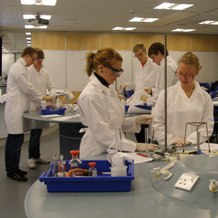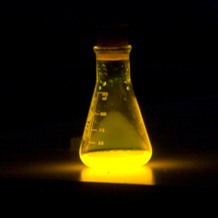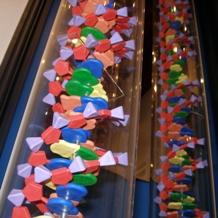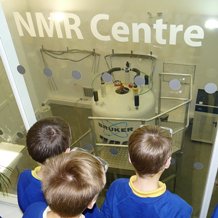Post-16
Activities and Events
Chemical Supermodels
Chemistry Careers Talk - Why Study Chemistry?
Students studying chemistry post-16 may not be fully aware of all the opportunities available to them when they complete their course. Some will have no clear idea of what to do next. Many believe that all chemists wear white coats and think that a degree in chemistry can only lead to a life in the lab. We can present a short talk, which shows students that this is not true; alerting them to the wide variety of career opportunities a chemistry degree opens up, both inside and outside the world of science. We can also include hints and tips about choosing an appropriate degree course and applying to university. We will allow plenty of time to answer questions at the end.
Colourful Chemistry - Demonstration Lecture
How have chemists brought colour to our lives? Why do chemists use colour to help them understand the world around them? What makes fireworks look so pretty? The answers to these and other burning questions will be answered in this exciting lecture, delivered by Dr Annie Hodgson from the University of York. Prepare to be amazed as colours change before your eyes, but don’t be surprised by the odd flash or bang along the way.
Discovering DNA and Molecules for Life
1) The most popular workshop takes about an hour and incorporates a lecture about the structure and function of DNA (fully illustrated). There is then a model-building workshop, led using a computer-animated version of the exercise. The model kits used are produced by Molymod. We build a sense strand of DNA (nine bases long) starting with nucleotides. By base-pairing we complete the molecule. We then use the anti-sense strand to make m-RNA and from that pick the three transfer RNA molecules required to bring in the three amino acids to build the tripeptide coded for by the gene. Each pair of students has a different sequence and were the sequences to be joined together it would produce the first part of the gene for the beta-strand of haemoglobin. This gene has been chosen, because quiet near the start is the position for the point mutation that leads to sickle cell anaemia.
2) A slightly longer (add about 15 min) version of the workshop has the activities above plus an exercise to make a bracelet in which the students each write their name in genetic code (the 4 bases being represented by 4 different colours of beads.) This is a bit of fun, it reinforces the message of the triplet code and the students are allowed to keep the bracelet.
3) The longest version of the workshop takes half a day and incorporates 1, 2 (if required) and a wet-lab exercise in which we extract DNA from kiwi fruit. This is incorporated into the other exercises in order to accommodate an incubation step. The workshop requires separate areas to do the dry exercises away from the wet benches (the kiwi exercise can get very messy).
Incredible Indigo
Just a Minute
Looking at Limonene
Sixth Form Chemistry Conference
This annual event comprises lectures and workshops to give students taking A-level chemistry (or equivalent) a taste of what it is like to study chemistry at university. The programme varies from year to year, but usually includes an opportunity to look at spectroscopy and to carry out a short practical in the teaching laboratories.
We regret that the 2021 conference has been cancelled due to the Covid-19 pandemic. Details of the 2022 conference will be provided here in due course.
Spectroscopy in a Suitcase (SIAS) - Infrared
These infrared spectroscopy activities are designed for post-16 students and those aspiring to study chemistry beyond GCSE level. Note that these activities are only available at times when we can access the University of York’s chemistry teaching laboratory in order to be able to use the instruments.
As an alternative, schools may wish to book a Spectroscopy in a Suitcase (SIAS) kit from the Royal Society of Chemistry (RSC). The SIAS scheme provides equipment and resources to use in schools, enabling students to get hands-on experience of spectroscopic techniques.
Formula 1 diagnostics
Infrared spectroscopy is routinely used to check the performance of and locate faults in Formula 1 racing cars. Students run IR spectra of fluids leaked from cars to identify where the faults might be, through pattern matching with sample spectra.
Festival drug testing
Those policing large music festivals use infrared spectroscopy to quickly identify substances that may potentially be illegal drugs. Run IR spectra of a range of white powders to identify them by pattern matching with sample spectra.
Drug purity
Infrared spectroscopy is used to check the purity of pharmaceutical products. Use IR to find out if the samples of aspirin or paracetamol you have synthesised are pure or contain contaminants.
What’s in the pot?
Traces of materials have been extracted from fragments of pot found at an archaeological site. Try to identify them by comparing their infrared spectra with those you run of drinks and foodstuffs that might have been stored in the pots.
The art of chemistry
Infrared spectroscopy is a non-destructive technique that can be used to help identify materials (such as paints, pigments and varnishes) used in fine works of art. This is useful to those restoring artworks, as well as those trying to spot fakes!
Spectroscopy in a Suitcase (SIAS) - Ultraviolet-visible
Light comes in a rainbow of colours and can tell us so much about the universe around us. Spectroscopy is a way to investigate these colours, revealing the chemistry happening in a test tube or in a galaxy far away. Using a portable Spectroscopy in a Suitcase kit, originally developed by the Royal Society of Chemistry (RSC), participants can engage with a range of demonstrations to discover the properties visible and ultraviolet (UV) light.
For further details about SIAS you can look at the RSC Spectroscopy in a Suitcase website where there are some resource packs available to download. It is envisaged that more teaching materials will be added to the site, so if you produce any resources using the SIAS kit that you would like to share, please let us know.
Even more resources relating to SIAS are available from the RSC SpectraSchool website, and from there you can find information about many other fascinating areas of chemistry.
Sun Cream Investigations
This is an exercise in which students have to work out which of three sunscreens is the most effective. They have to design their own experiment using the eqiupment provided, which includes some UV photochromic beads that are white until exposed to UV light, when they change to one of five colours. The students can make a bracelet of UV sensitive beads to keep.
What has Chemistry ever done for us? - Talk
Who is responsible for a doubling of human life expectancy? Who has revolutionised Olympic and Paralympic sport? Who has enabled us to watch television on our mobile phones? Who can tell how old archaeological remains are? Who can predict what will happen to our planet in the future? The answer to all of these questions is chemists. Find out how, in this whistle-stop tour through the world of chemistry.
Resources
Cash and Chemicals
Catalysis
Chemicals for Healthy Life: Emergency Care
Chemicals for Healthy Life: Tablet Coating
Chemicals for Healthy Life: Vitamin C
Controlling Chemical Reactions
Essential Chemical Industry
The new, fully revised Online Edition includes detailed information about the uses and manufacture of a wide range of chemicals. This book is used by teachers and students, various examination boards in the preparation of exam questions, and by the chemical industry to 'plug the gaps' in the knowledge and experience of new recruits.
Essential Plastics Industry
Greener Industry
Molecules Matter
![]()
The role played by chemicals in modern life is the theme of this resource, designed to support science, general studies and citizenship. All resources, including lesson plans and a 6 minute video clip, may be freely downloaded from this site. It also includes a regularly updated section with links to news articles on the topics covered.
Plastics: Guide to Workshop Practices
Polymers: Physical Testing
Product Design: Pop Bottles
Product Design: Sleeping Bags




